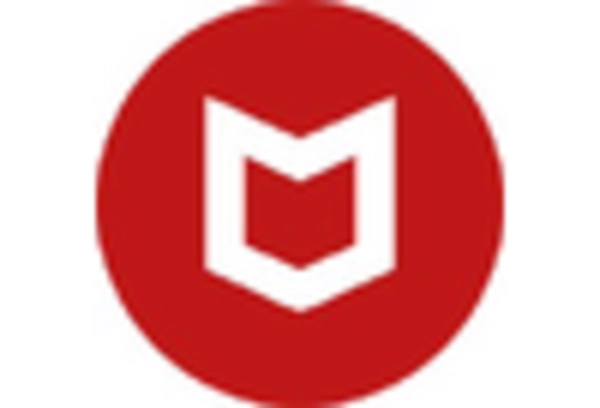Increasing Cyber Threats
The Digital Security Control Market is experiencing a surge in demand due to the escalating frequency and sophistication of cyber threats. Organizations across various sectors are increasingly targeted by cybercriminals, leading to substantial financial losses and reputational damage. In 2025, it is estimated that cybercrime could cost businesses over 10 trillion dollars annually. This alarming trend compels companies to invest in robust digital security measures to safeguard sensitive data and maintain operational integrity. As a result, the Digital Security Control Market is witnessing a significant uptick in the adoption of advanced security solutions, including intrusion detection systems and threat intelligence platforms, to mitigate risks associated with cyber threats.
Growing Adoption of IoT Devices
The proliferation of Internet of Things (IoT) devices is a key driver for the Digital Security Control Market. As more devices become interconnected, the potential attack surface for cyber threats expands, necessitating enhanced security measures. In 2025, it is projected that there will be over 30 billion connected IoT devices worldwide, each representing a potential vulnerability. This rapid growth prompts organizations to prioritize digital security controls to protect their networks and data. Consequently, the Digital Security Control Market is likely to see increased investments in IoT security solutions, such as device authentication and secure communication protocols, to address the unique challenges posed by this burgeoning ecosystem.
Rising Awareness of Data Privacy
The increasing awareness of data privacy among consumers and organizations is a pivotal factor propelling the Digital Security Control Market. As data breaches become more prevalent, individuals are becoming more conscious of their personal information and its protection. This heightened awareness is prompting businesses to adopt stringent security measures to build trust with their customers. In 2025, surveys indicate that over 70% of consumers are likely to choose companies that prioritize data privacy. Consequently, organizations are investing in digital security controls that not only protect data but also enhance transparency and accountability. This trend is likely to drive innovation within the Digital Security Control Market, as companies seek to develop solutions that align with consumer expectations.
Regulatory Compliance Requirements
The Digital Security Control Market is significantly influenced by stringent regulatory compliance requirements imposed by governments and industry bodies. Organizations are mandated to adhere to various data protection regulations, such as the General Data Protection Regulation (GDPR) and the Health Insurance Portability and Accountability Act (HIPAA). Non-compliance can result in hefty fines and legal repercussions, driving businesses to invest in comprehensive digital security controls. In 2025, it is anticipated that compliance-related expenditures will account for a substantial portion of the overall security budget for many organizations. This trend underscores the importance of integrating compliance-focused security solutions within the Digital Security Control Market to ensure adherence to evolving regulations.
Technological Advancements in Security Solutions
Technological advancements are reshaping the Digital Security Control Market, leading to the development of more sophisticated security solutions. Innovations such as artificial intelligence, machine learning, and blockchain technology are being integrated into security frameworks to enhance threat detection and response capabilities. In 2025, it is projected that the market for AI-driven security solutions will grow at a compound annual growth rate of over 20%. These advancements enable organizations to proactively identify vulnerabilities and respond to threats in real-time, thereby improving overall security posture. As a result, the Digital Security Control Market is likely to witness a surge in demand for cutting-edge security technologies that leverage these advancements to provide comprehensive protection against evolving cyber threats.

















Leave a Comment